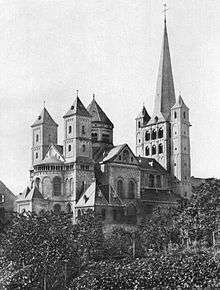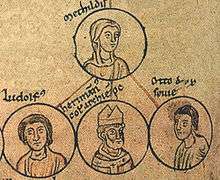Ezzo, Count Palatine of Lotharingia
| Ezzo | |
|---|---|
| Count Palatine of Lotharingia | |
| Spouse(s) | Matilda of Germany |
| Noble family | Ezzonen |
| Father | Herman I, Count Palatine of Lotharingia |
| Mother | Heylwig of Dillingen |
| Born |
c. 955 Lorraine |
| Died |
21 March 1034 Saalfeld |
Ezzo (c. 955 – 21 March 1034), sometimes called Ehrenfried, Count Palatine of Lotharingia of the Ezzonen dynasty, brother-in-law of Emperor Otto III, father of Queen Richeza of Poland and many other illustrious children, is undoubtedly one of the most important figures of the Rhenish History of his time.
Life
Ezzo was the son of Herman I, Count Palatine of Lotharingia. Born around 955, he was sent as a child to be educated by his relative, Bishop Ulrich of Augsburg (episcopate 923–973). Nothing is known about his youth.
Having married Matilda of Germany (died 1025), a daughter of Emperor Otto II and Theophanu, Ezzo became prominent during the reign of his brother-in-law, Emperor Otto III. The marriage was expressly consented by the Dowager Empress Theophanu, probably to rally the powerful family of Ezzo to the throne. Matilda received as dowry out of Ottonian possessions lands in Thuringia and Franconia (the East Frankish territories of Coburg, Salz and Orlamünde), while her husband gave her as dowry the family estate of Brauweiler. At the death of his father in 996, Herman I's rich allodial property was shared between his sons. Ezzo received lands in the Moselle, in Maifeld, the Flamersheimer Wald and the Tomburg as well as half the usufruct of Villewaldin. About the same time, he must have received the Palatinate and previous countal rights, as he is referred as Count in Auelgau in 1015 and as Count Palatine in Bonngau in 1020. He also received the county of Ruhrgau with tutelage of the Abbey of Essen.
Unsuccessful candidate to the imperial throne at the death of Otto III, his relation with the new Emperor Henry II was immediately very tensed. Henry II disputed Ezzo's ownership of territories, that Ezzo defended as his wife's inheritance of Otto III. The conflict dragged on for years, reached its peak in 1011. Facing disturbances in Lotharingia, and in need for Ezzo's military support, the emperor was forced to come to terms. Ezzo's victory led to Henry II to make concessions and to a complete transformation of its policy. He reconciled with Ezzo, recognized its rights of inheritance and gave him the royal territories of Kaiserswerth, Duisburg and Saalfeld for renouncing to the throne. He also associated the Palatine dynasty to his Eastern policies, and mediated the marriage of Ezzo's daughter Richeza with the heir to the Polish Duke Mieszko II.

These huge territorial concessions made Ezzo the most powerful man in the Empire, after the Emperor. Ezzo's growing power and the increased prestige of his house were reflected in the founding of the family Brauweiler Abbey near Cologne, the place where his marriage had been celebrated, whose construction begun after a trip to Rome of the couple in 1024. The monastery, which was consecrated in 1028 by Piligrim, archbishop of Cologne, was to be the grave and spiritual center of Palatine dynasty. The first member of the family buried there was Ezzo' wife Matilda, who died on 4 November 1025.
Very little is known about Ezzo's later life, but we are told that he died at a great age at Saalfeld on 21 March 1034, and was buried in Brauweiler.
Ezzo has been quite an impressive personality, even if the reporting on his life and offices, described by the glorifying author of "Fundatio monasterii Brunwilarensis" may be exaggerated. He was mostly active in political affairs when it came to his own interests and the standing of his house, and where he could increase his territories and authority. His dexterous management of the favours of Empress Theophano, Emperor Otto III and later Henry II, testify of his personal ambition and political dexterity.
Children

Ezzo and Mathilda left three sons and seven daughters. The first two sons, Liudolf and Otto were aimed at perpetuating the dynasty while the third Hermann, was raised to enter the clergy. Of the seven daughters only Richeza was conspicuously married, while the others were placed in monasteries of which they all became abbesses.
- Liudolf (c. 1000–10 April 1031), Count of Zütphen.
- Otto I (died 1047), Count Palatine of Lotharingia and later Duke of Swabia as Otto II.
- Hermann II (995–1056), Archbishop of Cologne.
- Theophanu (died 1056), Abbess of Essen and Gerresheim.
- Richeza (died 21 March 1063), Queen of Poland, married with King Mieszko II of Poland.
- Adelheid (died c. 1030), Abbess of Nivelles (Nijvel).
- Heylwig, Abbess of Neuss.
- Mathilde, Abbess of Dietkirchen and Villich.
- Sophie, Abbess of St. Maria, Mainz.
- Ida (died 1060), Abbess of Cologne and Gandersheim Abbey (founded in 852 by her ancestor Liudolf, Duke of Saxony).
After the death of his wife, Ezzo had another son named Henry (1055–1093), later Abbot of Gorze, with a concubine.
Sources
- Kimpen, E., ‘Ezzonen und Hezeliniden in der rheinischen Pfalzgrafschaft’, Mitteilungen des Österreichischen Instituts für Geschichtsforschung. XII. Erg.-Band. (Innsbruck 1933) S.1–91.
- Lewald, Ursula, 'Die Ezzonen. Das Schicksal eines rheinischen Fürstengeschlechts', Rheinische Vierteljahrsblätter 43 (1979) S.120–168.
- Steinbach, F., ‘Die Ezzonen. Ein Versuch territorialpolitischen Zusammenschlusses der fränkischen Rheinlande’, Collectanea Franz Steinbach. Aufsätze und Abhandlungen zur Verfassungs-, Sozial- und Wirtschaftsgeschichte, geschichtlichen Landeskunde und Kulturraumforschung, ed. F. Petri en G. Droege (Bonn 1967) S.64–81.
- Van Droogenbroeck, F.J., ‘Paltsgraaf Herman II (†1085) en de stichting van de abdij van Affligem (28 juni 1062)’, Jaarboek voor Middeleeuwse Geschiedenis 2 (Hilversum 1999) S.38–95.
- Van Droogenbroeck, F.J., ‘De betekenis van paltsgraaf Herman II (1064–1085) voor het graafschap Brabant’, Eigen Schoon en De Brabander 87 (Brussels 2004) S.1–166.
- Wolter, Heinz, Ezzo Pfalzgraf von Lothringen, http://www.rheinische-geschichte.lvr.de/persoenlichkeiten/E/Seiten/Ezzo.aspx.
| Ezzo, Count Palatine of Lotharingia Born: c. 955 Died: 21 March 1034 | ||
| Preceded by Hermann I |
Count Palatine of Lotharingia 1015–1034 |
Succeeded by Otto I |